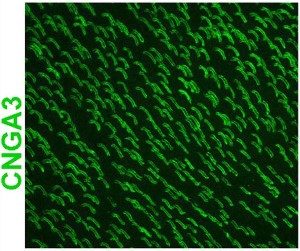Overview
- Peptide (C)GHGFSPDRENSEDASKAD, corresponding to amino acid residues 594-611 of rat CNGA3 (accession number Q9QWN7). Intracellular, C-terminus.
- Rat brain lysate (1:200).
 Western blot analysis of rat brain membranes:1. Anti-CNGA3 Antibody (#APC-060), (1:200).
Western blot analysis of rat brain membranes:1. Anti-CNGA3 Antibody (#APC-060), (1:200).
2. Anti-CNGA3 Antibody, preincubated with CNGA3 Blocking Peptide (#BLP-PC060).
- Rat brain frozen sections.
Cyclic nucleotides are important second messengers in many cellular functions such as visual transduction, and relaxation of smooth muscle cells. Cyclic nucleotides exert their cellular functions through three major classes of cellular receptors, one of them is the cyclic nucleotide-gated (CNG) channels.1 The CNG channels are non-selective cation channels facilitating the influx of Na+ and Ca2+ ions, following activation by intracellular cyclic nucleotides.2 In vertebrates, six members of the CNG channel family were identified and grouped according to sequence homology into two subtypes, CNGA and CNGB. The native CNG channels are composed of a and b subunits in a tetrameric configuration. To date, four types of the a subunits (CNGA1-4) and two b subunits (CNGB1, CNGB3) have been characterized.3-4
Each subunit contains 6 TM domains and intracellular cAMP or cGMP binding domains but, are also modulated by other factors including phosphorylation and calmodulin.5 In a heterologous expression system, only the a subunits are capable of forming functional homomeric channels.
CNG ion channels are essential in visual and olfactory signal transduction. The CNGA3 channel is primarily expressed in cone photoreceptors where it participates in light transduction (daylight and color vision). CNG channels expression was also found in the hippocampus, cortex, Purkinje cells and other neural derived tissues. CNGA3 was also detected in kidney, heart, brain and sperm, where it was thought to have an important role in the control of sperm motility and fertility. However, CNGA3-deficient mice were shown to be as fertile and produce at normal rate as wild types.6
Application key:
Species reactivity key:

Expression of CNGA3 in mouse neuroretina.Immunohistochemical staining of mouse neuroretina using Anti-CNGA3 Antibody (#APC-060). CNGA3 staining (green) is specifically detected in cone cells.Adapted from Sakurai, K. et al. (2016) Sci. Rep. 6, 32521. with permission of SPRINGER NATURE.
